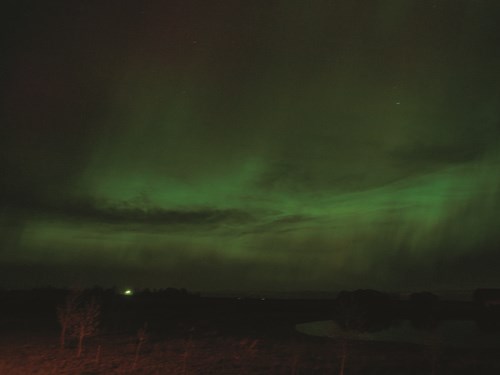Following a particularly strong solar flare that erupted from the sun early last week, the Northern Lights which followed were largely obstructed by clouds on Friday night in Estevan, and it looks like opportunities to see the glittering skies are growing dimmer by the year.
According to the former head of the Super Dual Auroral Radar Network in Canada (SuperDARN), George Sofko, a long-lasting study on our nearby star's sunspots has revealed some interesting facts, which means residents should maximize efforts to see the Northern Lights the next time they roll around.
"There are some astronomers using the McMath Pierce Telescope at Kitt Peak, Arizona who have been following these sunspots since 1992 and I can tell you, that the situation on the sun magnetically is becoming a lot quieter and quieter," said Sofko, who is also a former engineering physics professor from the University of Saskatchewan. "We should enjoy (the Northern Lights) because we might not be seeing them for much longer."
Sunspots are often the originating point of solar flares. These solar flares hurl high-energy particles into space - also known as solar winds - that make their way to our planet, and when these particles collide with our magnetic field it causes them to glow. This is known as the Aurora Borealis.
"The sunspot cycle goes with this 11-year cycle but there have been times in history when there were no sunspot cycles for long periods of time. We appear to be approaching one of those," said Sofko, adding that by 2020, the Northern Lights won't be visible for roughly 70 years if the patterns of the past hold up.
Sofko suggested there are no sunspots on the sun that contain a magnetic field of less than 1,600 gauss (G), and by 1997 the scientists at Kitt Peak discovered the sunspots' average magnetic field was decreasing at a rate of 50 G per year. At this rate, they predicted that by 2020, the average magnetic field for sunspots will reach the 1,600 G threshold, which therefore means they will essentially disappear.
Solar flares are known to knock out man-made satellites and power grids, at times even affect navigation equipment on airplanes. The minimal magnetic field this time around however, proved to do no such thing, noted Sofko.
There is another strong element to the prediction surrounding the Northern Lights diminishing, said Sofko, and it involves the rising temperatures of sunspots.
"The reason they're black, of course, is because if you put a low temperature spot on a high temperature surface, it makes it look dark. Colder bodies radiate less radiation so it doesn't look as hot," he explained.
The studies from Kitt Peak, he said, have also revealed rising temperatures within our star's sunspots, which by 2020, will reach the same temperature as the surface of the sun. The rising temperatures, combined with the aforementioned diminishing magnetic fields within these areas, Sofko said, could turn the Northern Lights into a thing of the past.
When it comes to the planet's erratic weather and global warming issues, the former head of the SuperDARN said the altered status of the sun's magnetic field may play a tiny part in it. He noted however, that our greenhouse emissions are playing a much bigger part role in the problem.
"Mankind has had such an effect on the climate that effects from the sun may be masked by the anthropogenic activity due to man. We live in interesting times," he said.




